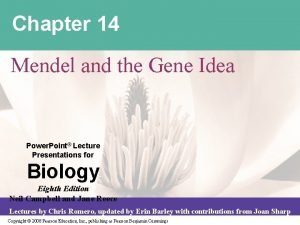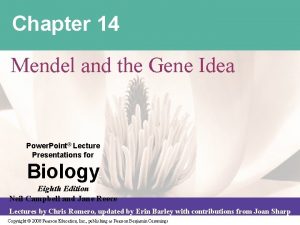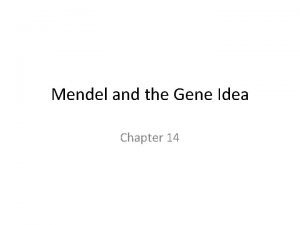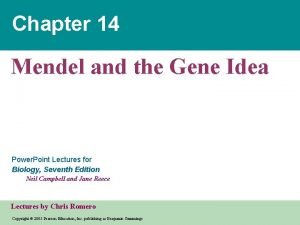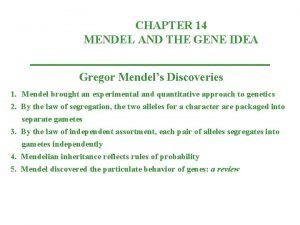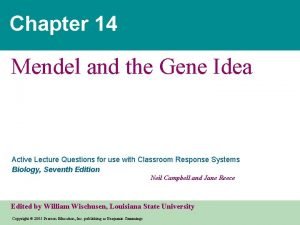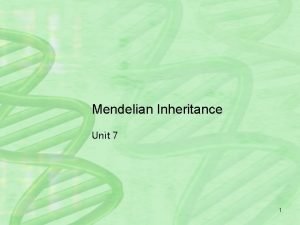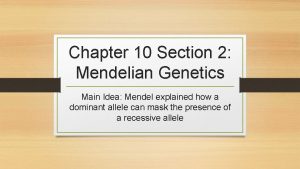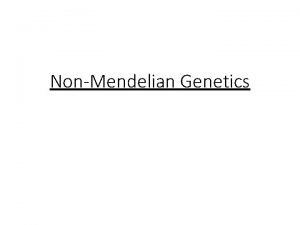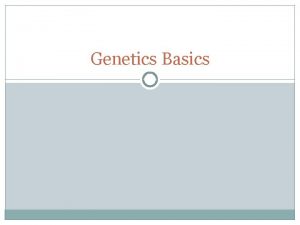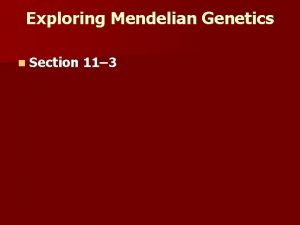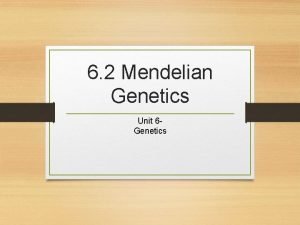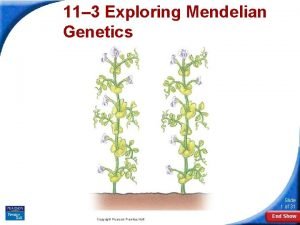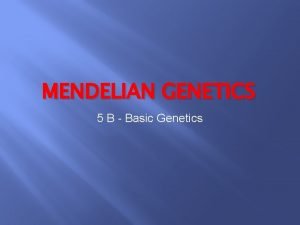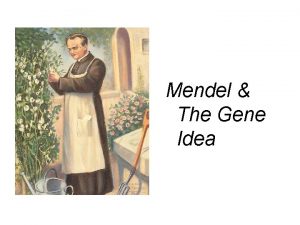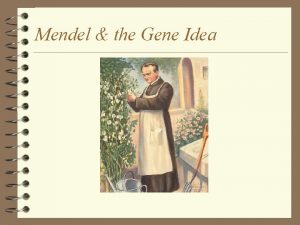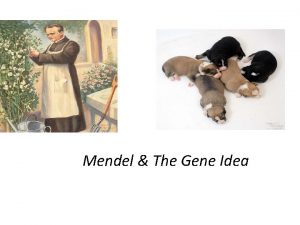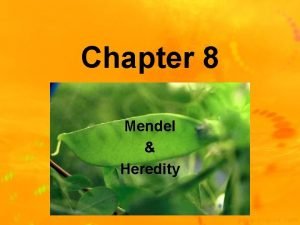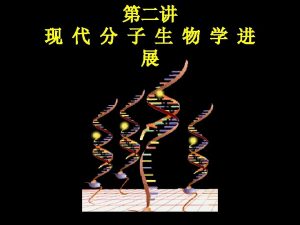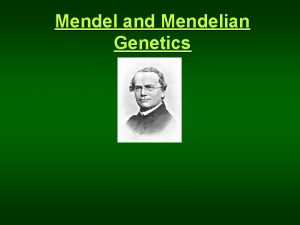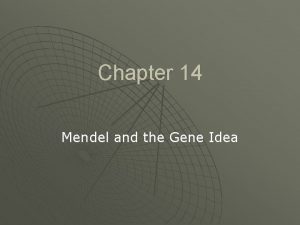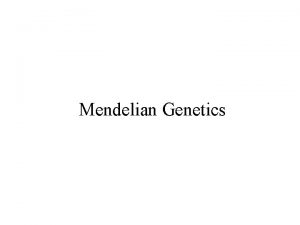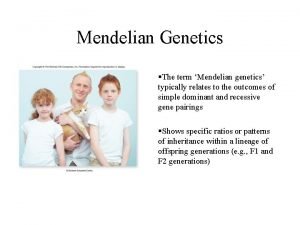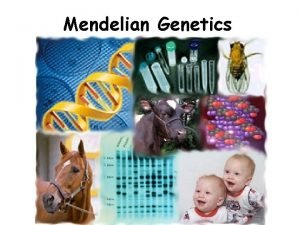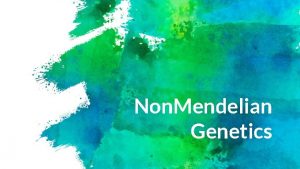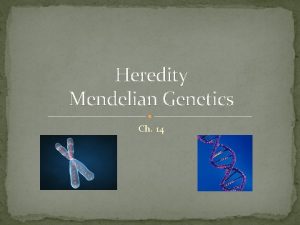Mendel The Gene Idea Chapter 14 Mendelian Genetics

















- Slides: 17

Mendel & The Gene Idea Chapter 14

Mendelian Genetics ■ Character - heritable feature; ex - fur color ■ Trait (allele) - variant for a character; ex- brown ■ True-bred (purebred) - homozygous for a trait ■ Hybridization - crossing of 2 different purebreds; ex – purple with white ■ P generation - parents ■ F 1 generation - first filial generation; filial = “son”; product of P generation ■ F 2 generation - product of crossing two from the F 1 generation

Genetics vocabulary……. ■ Punnett square: predicts the results of a genetic cross between individuals of a known genotype ■ Homozygous: pair of identical alleles for a character ■ Heterozygous: two different alleles for a character ■ Phenotype: an organism’s physical appearance ■ Genotype: an organism’s genetic makeup (allele combination) ■ Testcross: breeding of a recessive homozygote with a

The 3: 1 Ratio: What Must Be True 1. Alternative versions of genes (alleles) account for variations in inherited characters 2. For each character, an organism inherits 2 alleles, one from each parent 3. If the two alleles differ, then one, the dominant allele, is fully expressed in the organism’s appearance; the other, the recessive allele, has no noticeable effect on the organism’s appearance 4. The alleles for each character segregate (separate) during gamete production (meiosis) ending up in different gametes = Mendel’s Law of Segregation

Mendel’s Law of Independent Assortment ■ Mendel derived the Law of Segregation from following a single allele at a time (monohybrid crosses) ■ Mendel’s second law came about when he was following two alleles at a time (dihybrid crosses) ■ The segregation of one character does not influence the segregation of another character during gamete formation = Mendel’s Law of Independent Assortment

Practice 1. A pea plant heterozygous for inflated pods (Ii) is crossed with a plant homozygous for constricted pods (ii). Draw a punnett square for this cross and determine the genotypic and phenotypic ratios. 2. Pea plants heterozygous for flower position (Aa. Tt) are allowed to self-pollinate, and 400 of the resulting seeds were planted. Draw a punnett square for this cross. How many offspring would be predicted to have terminal flowers and be dwarf? See table 14. 1, pg 254 (7 th ed)or 265 (8 th ed)

Probability: Multiplication Rule ■ What is the probability that the offspring will be homozygous recessive (rr)? ■ Multiply the probability of the egg having an ‘r’ by the probability of the sperm having an ‘r’ ½x½=¼

Probability: Addition Rule ■ What is the probability the offspring will be heterozygous? ■ There are 2 ways to be heterozygous: Rr or r. R. ■ Calculate the probabilities of getting Rr and r. R and then add them together ¼+¼=½

Example Using Probabilities ■ What fraction of offspring from the cross below would be predicted to exhibit the dominant phenotypes for both of the characters? Yy. Rr x Yyrr

Practice 1. For any gene with a dominant allele C and a recessive allele c, what proportions of the offspring from a CC x Cc cross are expected to be homozygous dominant, homozygous recessive, and heterozygous?

2. An organism with the genotype Bb. DD is mated to one with the genotype BBDd. Assuming independent assortment of these two genes, write the genotypes of all possible offspring from this cross and use the rules of probability to calculate the chance of each genotype occuring.

3. Three characters (flower color, seed color, and pod shape) are considered in a cross between two pea plants (Pp. Yy. Ii x pp. Yyii). What fraction of offspring would be predicted to be homozygous recessive for at least two of the three characters?

Non-Dominant Variants ■ Incomplete dominance: blending appearance between the phenotypes of 2 alleles. Ex: snapdragons ■ Codominance: two alleles that affect the phenotype in separate, distinguishable ways. Ex: sickle cell anemia ■ Multiple alleles: more than 2 possible alleles for a gene. Ex: human blood types ■ Pleiotropy: genes with multiple phenotypic effects. Ex: cystic fibrosis & sickle cell

Genetics for Two or More Genes ■ Epistasis: a gene at one locus (chromosomal location) affects the phenotypic expression of a gene at a second locus. Ex: mice coat color ■ Polygenic Inheritance: an additive effect of two or more genes on a single phenotypic character Ex: human skin pigmentation and height

Human disorders ■ Can be traced using a family pedigree ■ Recessive disorders: - Cystic fibrosis - Tay-Sachs - Sickle-cell ■ Dominant disorders: - Huntington’s ■ Testing: - Amniocentesis - chorionic villus sampling (CVS)

Fig. 14 -15 b 1 st generation (grandparents) 2 nd generation (parents, aunts, and uncles) Ww ww ww Ww Ww ww 3 rd generation (two sisters) WW or Ww Widow’s peak ww No widow’s peak (a) Is a widow’s peak a dominant or recessive trait?

Fig. 14 -15 c 1 st generation (grandparents) 2 nd generation (parents, aunts, and uncles) Ff FF or Ff ff ff Ff Ff Ff ff ff FF or Ff 3 rd generation (two sisters) Attached earlobe (b) Is an attached earlobe a dominant or recessive trait? Free earlobe
 Mendel and the gene idea chapter 14
Mendel and the gene idea chapter 14 Chapter 14 mendel and the gene idea
Chapter 14 mendel and the gene idea Chapter 14 mendel and the gene idea
Chapter 14 mendel and the gene idea Chapter 14 mendel and the gene idea
Chapter 14 mendel and the gene idea Chapter 14 mendel and the gene idea
Chapter 14 mendel and the gene idea Chapter 14 mendel and the gene idea
Chapter 14 mendel and the gene idea Difference between mendelian and non mendelian inheritance
Difference between mendelian and non mendelian inheritance Extending mendelian genetics chapter 7
Extending mendelian genetics chapter 7 Chapter 10 section 2 mendelian genetics answer key
Chapter 10 section 2 mendelian genetics answer key Extending mendelian genetics
Extending mendelian genetics X linked recessive punnett square
X linked recessive punnett square Mendelian genetics vocabulary
Mendelian genetics vocabulary Non mendelian genetics multiple alleles
Non mendelian genetics multiple alleles Section 11-4 meiosis answer key
Section 11-4 meiosis answer key Heterozygous b blood type
Heterozygous b blood type Section 11-3 exploring mendelian genetics
Section 11-3 exploring mendelian genetics Mendelian genetics punnett square
Mendelian genetics punnett square 11.3 exploring mendelian genetics
11.3 exploring mendelian genetics
